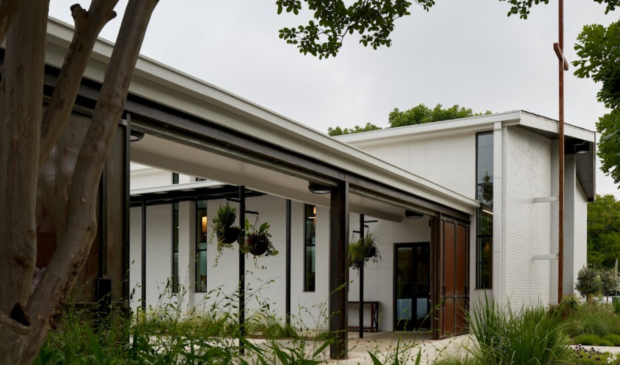East Austin church rezoning reveals cracks in DB90
Wednesday, August 21, 2024 by
Elizabeth Pagano Plans to expand an East Austin church are moving forward, but not before they sparked criticism of the city’s new density bonus program, DB90, at the Planning Commission last week.
Christ Church of Central Austin, which is located at San Marcos and Medina streets in the Cesar Chavez neighborhood, went to the Planning Commission in pursuit of a zoning change on two parcels of land. The change would allow them to expand their church and, in the future, build housing and commercial space.
“We don’t plan to be a megachurch,” said Emily Padula, who was representing the board and staff of the church. “We don’t plan to sell, we plan to stay. And we plan to be good neighbors.”
Though the church is just 950 feet east of the city’s Imagine Austin downtown center and 300 feet south of Plaza Saltillo, it also abuts a pocket neighborhood that is home to at least five historic structures, including the property directly to the south of the project. Because of this, city planning staff was recommending a less-intense zoning than the one developers sought.
In the end, Planning Commission members supported the developer’s request – DB90 on the southern 0.88-acre tract, and mixed-use zoning on the northern tract – amending the list of allowed uses to be more in line with the less-intense zoning recommended by staff. Commissioners voted 8-4 to approve the church’s request, with commissioners Adam Haynes, Alberta Phillips, Grayson Cox and Jennifer Mushtaler in opposition.
Victoria Haase, who was representing the church and Thrower Design, said that they originally intended to use DB90 entitlements on the northern tract but, after talking to the neighborhood association, they realized height was the biggest sticking point. The church modified their request to mixed use instead, which will still allow for housing and commercial space but would comply with compatibility standards that reduce allowed height based on a building’s proximity to single-family homes.
Haase explained the church needs more space for its parish house, office and classroom space, and would like to improve a dirt parking lot. In addition, the church hopes to build housing units in the future with a commercial use on the ground floor, like a preschool or a coffee shop.
The new request will keep the building limited to 60 feet in height, allowing for 100 units and structured parking. Haase explained that an alternative plan, which is supported by staff, would limit the height to 45 feet but “result in a suburban-style building” without structured parking.
Though the zoning on the other tract would be DB90, a zoning category that is meant to encourage density through development incentives and allows buildings to be 90 feet tall by right, Hasse said that the church had no desire to build over 75 feet.
However, developers can not put a conditional overlay limiting the height on a DB90 case, according to law.
“Realistically, what we’re hearing from clients is DB90 is going to end up resulting mostly in 75- to 80-foot-tall buildings, just because the cost of construction doesn’t pencil out for one additional floor,” she explained. “The cost of construction to go over 75 feet is significantly more.”
Cox, one of the commissioners, said that perspective was “interesting.”
“I’m hearing from a bunch of residents that are realizing what DB90 is, and they are hating it,” Cox said. “So we seem to be running into DB90 issues from all angles. … I think every case of DB90 this commission approves is actually growing the opposition to DB90.”
“It’s just completely and utterly inappropriate in this particular part of Austin,” said Cox, who noted the change would “blow up” the existing land use “with max entitlements under a DB90 zoning case.”
Commissioner Felicity Maxwell said that, to her, the case sounded like another plea to City Council to think about creating different density bonus standards with variable heights.
“I think that the number 90 is causing a lot of anxiety, unnecessarily, because this is a good tool,” she said. “If we had different height levels and different formats, we wouldn’t be trying to fit square pegs in round holes.”
Though no neighbors spoke against the rezoning at the Planning Commission hearing, Bruce Hughes wrote, in opposition, “that type of rezoned development will destroy the little peace we have left in this residential neighborhood.”
To some extent, city planning staff appeared to agree with that assessment. Jonathan Tomko, who is with the Planning Department, explained that the neighborhood was a “pocket neighborhood” that wasn’t really part of downtown, Plaza Saltillo or the nearby commercial corridor. Because of that, Tomko explained, “opening the door to additional height could set a precedent for non-churches or other properties within that area to seek higher zoning, and it could have substantial impacts on that neighborhood,” in terms of the single-family and historic homes that are currently there.
But the majority of Planning commissioners disagreed.
“I don’t think there is anything fundamentally incompatible with a 60-foot-tall or five-story building in a dynamic, thriving, mixed-use neighborhood that is literally steps from downtown,” Commissioner Ryan Johnson said. “If there’s anywhere in the city that we should be allowing more density, as opposed to less … it’s here, in what is functionally a part of the central core of our city.”
The Austin Monitor’s work is made possible by donations from the community. Though our reporting covers donors from time to time, we are careful to keep business and editorial efforts separate while maintaining transparency. A complete list of donors is available here, and our code of ethics is explained here.
You're a community leader
And we’re honored you look to us for serious, in-depth news. You know a strong community needs local and dedicated watchdog reporting. We’re here for you and that won’t change. Now will you take the powerful next step and support our nonprofit news organization?




